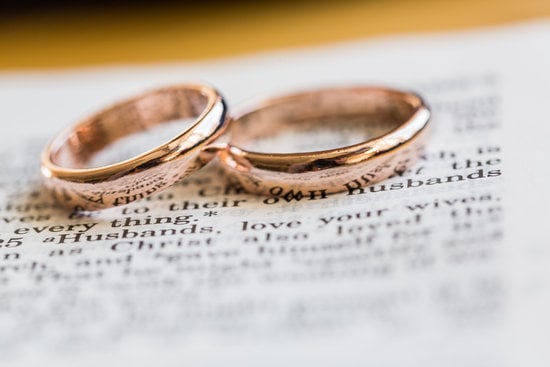When it comes to expressing love and commitment in a tangible form, few symbols are as universally recognized as the wedding ring. But have you ever wondered why we wear wedding rings on the left hand? This age-old tradition holds deep significance across cultures and religions, representing a timeless bond between two individuals embarking on a journey of love and partnership.
Dating back to ancient times, the act of exchanging rings during marriage ceremonies has been a steadfast custom that transcends generations. The left hand, particularly the ring finger, became designated as the ideal placement for this symbolic adornment due to its connection to matters of the heart. This tradition has stood the test of time, shaping the way we view and understand the meaning behind wearing a wedding ring on this specific hand.
Beyond its historical origins, the symbolism behind wearing a wedding ring on the left hand is rich with emotion and meaning. It serves as a constant reminder of the vows exchanged between partners, signifying loyalty, devotion, and eternal love. While cultural differences and religious beliefs may influence variations in this practice, the underlying message remains consistent – a testament to the enduring bond shared by two individuals united in marriage.
Historical Origins
Wedding rings have long been a symbol of love and commitment, transcending time and cultures. The act of exchanging rings during a wedding ceremony is a tradition that dates back centuries, with various customs and practices influencing how we view and wear these symbolic pieces of jewelry.
One common question that often arises is: why do we wear wedding rings on the left hand? Delving into the historical origins of this tradition can shed light on the significance behind this age-old custom.
The Ancient Tradition Behind the Left Ring Finger
The practice of wearing wedding rings on the left hand can be traced back to ancient Egypt, where it was believed that a vein called the “vena amoris” or the “vein of love” ran directly from the fourth finger on the left hand to the heart. This connection between love and the heart led to the belief that wearing a ring on this finger symbolized an unbreakable bond between two individuals.
This tradition carried over into ancient Rome, where it became customary for couples to exchange rings as a sign of their commitment.
Influence of Medieval Europe
During medieval times in Europe, this tradition was further solidified as Christian ceremonies incorporated the exchange of rings as part of marriage rituals. The placement of the wedding ring on the left hand became standardized, with religious symbolism reinforcing the significance of wearing it on this particular finger. As Christianity spread throughout Europe, so too did the custom of wearing wedding rings on the left hand, becoming ingrained in Western culture.
Continuation Into Modern Times
While some may view these traditions as antiquated beliefs or superstitions, many couples today continue to honor and respect these historical practices by choosing to wear their wedding rings on their left hands. The romantic notion that a ring placed on this finger connects directly to one’s heart still holds appeal for those who cherish tradition and symbolism in their marriage.
Despite changing societal norms and cultural differences, the act of wearing a wedding ring on the left hand remains a powerful symbol of everlasting love and commitment for many couples around the world.
Symbolism and Meaning
Wedding rings hold a deep symbolism in our society, representing the everlasting love and commitment between partners. The tradition of exchanging rings during a wedding ceremony dates back centuries, symbolizing the eternal bond two individuals share. One of the most intriguing aspects of this tradition is the placement of the wedding ring on the left hand, specifically on the ring finger.
But why do we wear wedding rings on the left hand? Let’s delve into the symbolic meaning behind this age-old tradition.
There are several theories as to why wedding rings are traditionally worn on the left hand, with one of them tracing back to ancient Egypt. It was believed that the “vena amoris” or vein of love ran directly from the heart to this particular finger, signifying a direct connection between love and this finger.
This belief led to the custom of placing wedding rings on the left hand’s fourth finger, symbolizing a direct link to one’s heart and emotions.
In addition to ancient Egyptian beliefs, wearing a wedding ring on the left hand became a common practice in many Western cultures over time. This custom has been passed down through generations as a way to symbolize unity, loyalty, and fidelity between partners.
The act of wearing a ring on this specific finger serves as a reminder of the love shared between two individuals and their commitment to each other through thick and thin. Whether it be due to historical significance or sentimental value, wearing a wedding ring on the left hand continues to hold profound symbolism in today’s society.
Cultural Differences
Wedding rings are a universal symbol of love and commitment, but the placement of these rings on the left hand is not always consistent across different cultures and countries. In many Western countries, wearing the wedding ring on the fourth finger of the left hand is a common practice. This tradition can be traced back to ancient Rome and Egypt, where it was believed that a vein ran directly from this finger to the heart, symbolizing eternal love.
However, in some Eastern cultures such as India and Russia, the right hand is traditionally chosen for wearing wedding rings. In Indian culture, the right hand is considered more auspicious and symbolic of strength and power. In contrast, Russian Orthodox Christians wear their wedding rings on their right hands during the wedding ceremony but switch them to their left hands afterwards. These variations highlight the diversity in cultural traditions surrounding marriage symbols.
Additionally, in some cultures like Jewish tradition or certain Eastern European countries, couples may choose to wear their wedding rings on different fingers altogether. For example, in Jewish customs, some may opt to wear the ring on the index finger or another unique placement. These cultural differences showcase how diverse beliefs and practices influence where individuals choose to wear their wedding rings.
- In many Western countries like America and Europe, wearing a wedding ring on the left hand is a common tradition.
- Eastern cultures such as India and Russia often place importance on wearing wedding rings on the right hand.
- Certain cultures like Jewish tradition may have unique finger placements for wedding rings.
Religious Significance
Religious beliefs and practices play a significant role in influencing the placement of wedding rings on the left hand. In many religious traditions, the left hand is considered to be closer to the heart, symbolizing love and fidelity.
For Christians, wearing a wedding ring on the left hand is often seen as a representation of the marriage covenant and commitment made before God. The circular shape of the ring is also seen as symbolic of eternity, reflecting the everlasting nature of marriage in religious teachings.
Christian Traditions
In Christian weddings, the exchange of rings is an important part of the ceremony, symbolizing the joining of two individuals in holy matrimony. The tradition of wearing wedding rings on the left hand dates back to early Christian practices where it was believed that a vein ran directly from the fourth finger on the left hand to the heart, known as the “vena amoris” or vein of love.
This belief added further significance to wearing wedding rings on this particular finger as a symbol of love and devotion.
Other Religious Beliefs
Similarly, in Jewish weddings, there are customs surrounding the placement of wedding rings. In some Jewish traditions, both partners may wear their rings on their right hands during the ceremony and then switch them to their left hands after being pronounced married.
Hindu weddings also have specific rituals regarding wedding jewelry placement, with rings sometimes worn on specific fingers based on cultural norms and customs. Overall, religious significance plays a major role in why we wear wedding rings on the left hand across various faiths and beliefs.
Practical Reasons
Wedding rings have long been regarded as a symbol of eternal love and commitment between partners. The act of exchanging rings during a wedding ceremony is a tradition that dates back centuries and is deeply ingrained in many cultures around the world.
One of the interesting aspects of wearing wedding rings is the specific placement on the left hand, which raises the question: why do we wear wedding rings on the left hand? This practice has historical origins that are rooted in ancient customs and traditions.
Historically, the tradition of wearing wedding rings on the left hand can be traced back to ancient Egypt, where it was believed that the vein of love, also known as Vena Amoris, ran directly from the heart to the fourth finger of the left hand. This romantic notion led to the custom of placing engagement and wedding rings on this particular finger to symbolize love and commitment.
Over time, this tradition has been passed down through generations and remains prevalent in many parts of the world today.
In addition to its historical significance, there are also practical reasons behind wearing wedding rings on the left hand. For instance, most people are right-handed, and placing a ring on the non-dominant hand reduces wear and tear on the jewelry.
Furthermore, by following this long-standing tradition, individuals can easily recognize someone’s marital status based on which hand they wear their ring on. Ultimately, combining both practicality and tradition has solidified the left hand as the customary placement for wedding rings in many cultures across different societies.
| Aspect | Explanation |
|---|---|
| Historical Origins | Ancient Egypt believed in Vena Amoris connection |
| Practical Reasons | Reduces wear-and-tear on jewelry for right-handed individuals |
| Societal Norms | Recognizing marital status based on ring placement |
Social Influence
Social norms and societal expectations play a significant role in why we wear wedding rings on the left hand. In many Western cultures, it is customary for both men and women to wear their wedding rings on the fourth finger of their left hand. This tradition can be traced back to ancient Greece and Rome, where it was believed that the vein in the ring finger, known as the “vena amoris” or “vein of love,” connected directly to the heart.
The symbolism behind wearing a wedding ring on the left hand is deeply ingrained in our culture. By placing the ring on this finger, couples symbolize their connection, love, and commitment to each other. The left hand is often associated with matters of the heart and emotions, making it a fitting choice for a symbol of marriage and unity. Additionally, the constant visibility of the ring on this hand serves as a daily reminder of the vows exchanged between partners.
While some may choose to deviate from this tradition for personal or cultural reasons, the social influence surrounding wearing wedding rings on the left hand remains strong. People often adhere to these norms because they provide a sense of belonging and conformity within their community. The act of exchanging rings has transcended mere jewelry-wearing and has become an essential part of weddings that signifies not only love but also acceptance and validation within society.
| Reasons for Wearing Wedding Rings on Left Hand | Significance |
|---|---|
| Symbolism & Tradition | Represents connection, love, commitment |
| Social Acceptance | Provides sense of belonging & conformity within community |
| Daily Reminder | Serves as daily reminder of vows exchanged & unity between partners |
Modern Trends
In today’s society, the tradition of wearing wedding rings on the left hand may still hold strong significance for many couples. However, modern trends and alternative options have emerged that allow individuals to express their commitment in new and unique ways. While the left hand remains a popular choice for placing wedding rings, some couples opt to wear them on different fingers or even hands as a symbol of personal preference or individuality.
Despite the historical roots of why we wear wedding rings on the left hand, societal norms and expectations are constantly evolving. As a result, more couples are embracing the freedom to choose how they wish to symbolize their love and bond with each other. Some may find significance in wearing their wedding ring on a different finger that holds personal meaning or represents a specific memory shared between partners.
Ultimately, whether one chooses to follow tradition by wearing their wedding ring on the left hand or decides to explore alternative options, the most important aspect is the intention behind this symbolic gesture of love and commitment. In a world where customs and practices continue to change, what truly matters is the bond shared between two individuals and the meaning they attach to their chosen way of displaying that enduring connection.
Frequently Asked Questions
Why Are Wedding Rings on the Left Hand?
Wedding rings are traditionally worn on the left hand because of a belief that there is a vein in the ring finger that is directly connected to the heart. This romantic notion has been passed down through generations, symbolizing love and commitment.
What Does It Mean to Wear a Wedding Ring on Your Right Hand?
Wearing a wedding ring on the right hand can have different meanings depending on the cultural context. In some countries or cultures, it may signify a relationship status, such as being single or divorced. For others, it could be a personal choice or simply based on comfort and aesthetics rather than any specific tradition.
Is There a Vein in Your Left Ring Finger?
The belief that there is a vein in the left ring finger called the “vena amoris” dates back to ancient times and has been debunked by modern science. While there are veins in our fingers, there is no one specifically connected to the heart.
Nevertheless, this myth continues to be perpetuated as a symbol of everlasting love and unity between partners exchanging wedding rings.

I have been involved in marriages for over 20 years helping couples and singles understand more about them.





